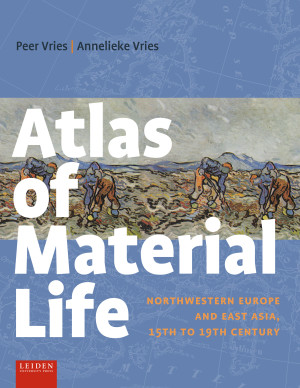“The Atlas of Material Life stands out on three points in particular. First, it introduces the practices, if not the fully developed methodology, of comparison between Europe and its quintessential East Asian “other” in an accessible, unobtrusive, and data-rich way. […] Second, Peer Vries is very good at dealing with quantification, something that is all too often regarded in global history studies as unnecessary pedantry. As in many previous publications, Vries draws the reader’s attention to the limits of the knowable, the illusions of exactness, the perils of estimates, and the strength of common sense in assessing claims of accuracy. […] Third, Annelieke Vries’s maps are always devised with a keen eye on the usefulness that the authors consider a defining feature of their Atlas. […] On the whole, this is a textbook in the best sense: useful in many different respects, pleasing in its visual appearance, and never concealing the personal voice of a committed scholar and teacher."
- Jürgen Osterhammel, University Professor, Freiburg University
“This book is impressive because of its wide scope, treating numerous aspects of the economic and societal history of very different countries over a long period. Best of all, however, is the fact that the data are systematically selected and presented in ways that make worldwide comparisons possible, especially between Europe and Asia. […] It was a very good choice to match the text with a variety of figures, considering the increasing popularity of data visualization. The figures are attractive ad effective, giving the reader quick impressions of important historical developments. […] The authors have done an excellent job by opening up the field of global economic history in this way.”
- Milia van Tielhof, Senior Researcher, Huygens Institute for the History of the Netherlands
"The comparative data are very useful and sometimes on their own revealing. Having all this between two covers (or in one digital file) will be very handy for all those scholars who work in, or dabble in, macro-scale economic history. […] The subject matter – large-scale comparative economic history of westernmost and easternmost Eurasia – is of first-rate importance for world history."
– John McNeill, University Professor, Georgetown University
“Throughout the book, the data is presented clearly and succinctly, drawn from a very wide array of mostly secondary sources but organized in a manner that makes comparisons across space and time feasible. Much of that clear presentation is due to the work done by Annelieke Vries: she is responsible for all the excellent maps as well as the lay-out of the book. […] But its real value lies in making the very complex, often inaccessible and mostly incomparable data contained in those scattered sources simple, accessible and comparable, and that makes this a very welcome contribution to the arsenal of resources we can make use of in teaching but also in our research. We owe the Vrieses a dept of gratitude for doing this.”
- Anne Gerritsen, University Professor, University of Warwick, Leiden University





